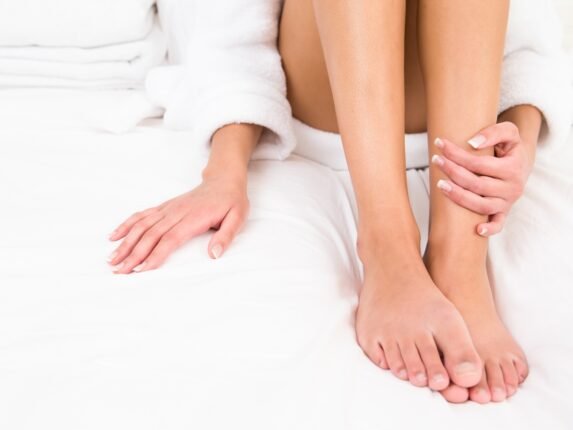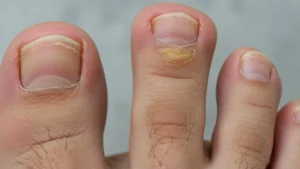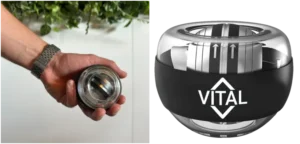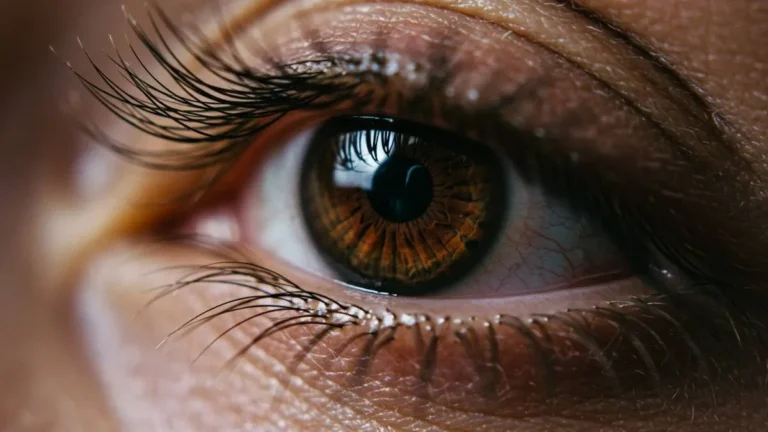Onychomycosis, or nail fungus, is an infection usually caused by a parasitic fungus that infects the nail. Damaged, yellowed, and peeling nails affected by onychomycosis require specific treatment, followed rigorously for several months.
About 10% of the population suffers from onychomycosis—a fungal infection of the nail bed, most commonly affecting the big toenail. Here’s an overview of the causes of onychomycosis, its symptoms, and treatments for this often-overlooked nail fungus. What should you do if you have nail fungus?
Symptoms: how to recognize onychomycosis (yellow nail, etc.)?
Onychomycosis caused by microscopic fungi occurs primarily on the feet, specifically at the corner of the big toenail. Symptoms include:
- Thickened, detached, and yellowish nail;
- A whitish, contagious powder appears when scratched under the nail;
- Appearance of white spots on the surface of the nail;
- Appearance, much more rarely, of black spots (which require the advice of a specialist).
When caused by yeast, nail fungus tends to affect the fingernails. The symptoms are essentially the same, namely:
- a detachment of the nail under which a yellowish-white coating forms;
- skin around the nail swollen, red, painful;
- Superinfection by bacteria can lead to the appearance of a green pigment, giving a moldy appearance to the nail.
These same symptoms characterize onychomycosis due to mold.
Causes: How do you get toenail fungus?
Nail fungus is most often caused by dermatophyte fungi, more rarely by yeasts or molds. These germs have in common a fondness for warm, humid places.
- Nail fungus caused by dermatophytes generally follows a foot fungus (known as athlete’s foot), contracted on public floors infected by skin fragments left by sick people. This is particularly the case in swimming pools, saunas, steam rooms, sports locker rooms, doctors’ offices, dance halls, etc. After several months, untreated athlete’s foot spreads to the nail and causes onychomycosis.
- Yeasts can also cause onychomycosis in the fingernails. These fungi proliferate under the nails of people who are in excessive contact with water.
- Mold contamination can occur through contact with contaminated soil.
Nail fungus (feet, hands): risk factors
While rare in children, nail fungus is very common in adults, affecting approximately 1 in 10 adults. Its prevalence increases with age, reaching 30% in those over 70. Onychomycosis affects men three times more than women. However, in cases of fungus caused by contamination by certain germs, various factors can promote this infection:
- Some diseases (diabetes, HIV infection, AIDS, blood circulation disorders, skin diseases, etc.) and treatments (immunosuppressants, chemotherapy, cortisone…);
- Overlapping or upturned toes, bumps, or bruises caused by sports activities or ill-fitting shoes;
- Humidity: wearing poorly ventilated shoes, professions, and/or activities requiring frequent contact with water;
- Walking barefoot on floors in public places (sauna, swimming pool, etc.);
- Aging.
Diagnosis of nail fungus
Diagnosis of onychomycosis relies on a mycological examination, an essential prerequisite for ruling out other nail diseases. Unpleasant but not painful, the mycological sampling requires cutting the detached nail as far back as possible and scraping off the powdery debris.
If the symptoms of onychomycosis are white spots on the nail surface, the doctor will scrape the nail for analysis. Few laboratories specialize in nail sampling and analysis, so results can take a relatively long time to obtain (approximately 1 month).
How to treat nail fungus (polish, tablets, surgery)?
Treatments for nail fungus can combine local treatments with systemic treatments, depending on the severity and extent of the infection.
What is the most effective treatment for nail fungus? Should I cut the nail?
In the early stages of onychomycosis, applying an antifungal cream or a treatment varnish for two to six months is enough to get rid of the onychomycosis.
Sometimes, the diseased nail must be removed using a paste applied daily and covered with a bandage. The treated nail will crumble after the treatment, which lasts between two and four weeks; if it is not destroyed, the doctor will have to cut it with special tweezers. An antifungal cream or a treatment varnish completes this treatment.
How to treat toenail fungus quickly?
If this fails, or for moldy nail fungus, surgical removal of the nail is essential.
Advanced forms, on the other hand, require general treatment. It lasts two to six months and is taken orally, and can cause side effects that are generally mild (digestive problems, redness), but sometimes more serious (hypersensitivity, rash, blood abnormalities, etc.).
Whatever treatment is prescribed, its success depends on its rigorous monitoring, despite its often very long duration.
How to treat big toe fungus naturally?
If you have a toenail fungus, medical treatment is often essential. However, depending on your doctor’s advice, it may be possible to supplement it with natural remedies, only if there are no known side effects. These home remedies can also be used to prevent recurrences.
This could be, for example:
- Essential oils, such as tea tree essential oil or lemon essential oil;
- Foot baths with baking soda or cider vinegar;
- A course of probiotics to rebalance the body’s flora.
Which specialist should I consult in case of toenail fungus?
In the case of toenail fungus, several health specialists can be consulted to obtain a diagnosis and appropriate treatment.
The general practitioner: He is the first recommended contact; he can make an initial diagnosis, prescribe the first treatments, and refer you to a specialist if necessary.
Dermatologist: As a specialist in skin and nail diseases, a dermatologist can make an accurate diagnosis and prescribe more specific treatments. It is recommended for complex or resistant cases.
The podiatrist: This foot care expert performs localized treatments. They can help you prevent recurrences and advise you on daily hygiene.
It’s important to consult one of these professionals as soon as the first symptoms appear to prevent the infection from worsening and spreading to other nails. The specialist consulted will be able to take a fungal sample to confirm the diagnosis and adapt the treatment accordingly.























+ There are no comments
Add yours